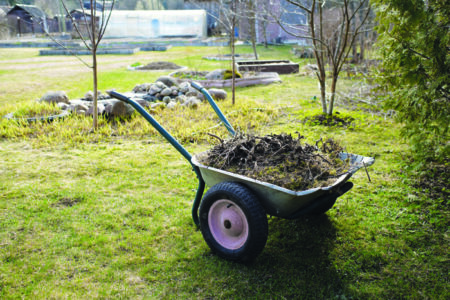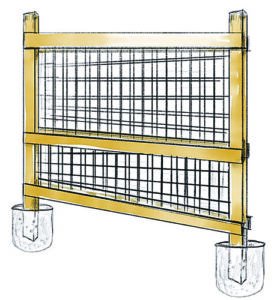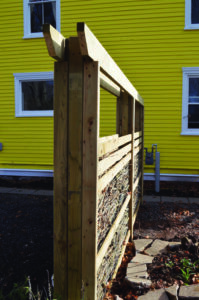Here’s what to consider for constructing a compost fence, an ideal structure for composting yard waste while adding privacy to your yard.
What if your fence was alive? As typical pressed-lumber and chain-link fences certainly aren’t beacons of life, a living fence may seem like a magical notion. What a marvelous way to incorporate yet more life and diversity into the garden! Yet, despite the concept sounding revolutionary, in truth, “living fences” can be found on many residential streets in the form of hedges.
What’s a Compost Fence?
A compost wall or fence, on the other hand, is more unconventional and adventurous than a hedge. A compost fence is essentially a solid non-compostable structure, usually two fences with mesh walls built side by side with a pocket between them made to envelop compost. This compost-containing structure can be casual or a fancy latticed pergola-type structure. You can then fill your “hollow fence” with all kinds of compostables and allow them to decompose.
Compost fences are generally filled with “brown” compost materials, such as fall leaves, branches, and perennial clippings, but anything goes! The resulting mass of natural material creates a screen that blocks noise and provides privacy. Additionally, the compost provides living spaces for insects and birds. And as humus is generated by the compost’s microorganisms, you can insert hardy plants into it through the mesh to clothe the compost fence in green.
Composting Yard Waste with a Compost Fence
A compost fence appealed to me as a useful way of composting yard waste — repurposing all the tree branches and trimmings that accumulate, even in our small yard. The usual destination for piles of fruit tree prunings in spring is a landfill or, hopefully, municipal compost program. A compost fence provides a full-circle solution, creating a use for what’s usually waste.

We built our first compost fence as a privacy wall, providing a sheltered place to sit in full sun, blocking the path of wind and the view from the sidewalk. An overgrown lilac hedge supplied the fill for the fence, as the property was bordered on two sides by a dense, towering lilac hedge. Various gardening sources claimed that the best way to revive an ancient lilac hedge was to cut all the old wood down to the ground. I did this, and it was effective, but this lilac-revival technique also created a dramatic pile of branches and small tree trunks, perfectly sized for filling a fence.
Other items you can place in your compost fence
- Fall leaves
- Branches
- Tree trunks, sliced into circles, cut to the correct width to fit your fence
- Soil
- Grass clippings
- Pine cones
- Pine needles
- Rocks (for texture and color)
- Christmas tree branches
- Natural winter holiday decorations
- Old bouquets and houseplants
Additional Benefits of a Compost Fence
Along with serving as a receptacle for tree branches and fallen leaves, a compost fence offers additional benefits:
- Habitat for insects
- Extra planting space, once a spot in the fence has become humus or been filled with soil
- Shelter for birds
- Effective noise reduction
- Wind reduction
- Great privacy
- Excellent location for planting climbers that cling with aerial roots, such as climbing hydrangea
- Ideal spot for growing hardy perennials or edible plants, such as alpine strawberries, once planting space is available
- I’m planning to plant alpine strawberries in my own compost wall. I already grow them in raised beds, but strawberries are an excellent plant for a vertical garden. Alpine strawberries could benefit from wall-type planting, as they’re delicate, and many creatures seem to find them delicious when they’re in more-available locations. They also tend to be hardy plants. I can’t imagine how anyone could ever have too many of these strawberries!
How to Build a Compost Fence for Composting Yard Waste
We built our compost fence using pressure-treated lumber for the fence posts and structure and welded-wire fencing for the mesh. We dug each fence posthole 3 feet down and set the posts in concrete. We attached two identical panels of wood and mesh to the fence poles, creating a narrow rectangular box open on the top and bottom.

After deciding on your location and measuring the distance between posts, dig 3-foot holes for each fence post. Ensure the posts are in a straight line and level. We used 10-foot posts, making the height of our fence 7 feet. We used Sonotube concrete tube forms and cement to set the posts. Because we built our fence in November (after cutting down our lilacs), we let the concrete dry for three days. In warmer weather, it will take a lot less time to set.
In our case, we used 4×4 pressure-treated posts. Initially, we planned to attach metal mesh to the outside of the posts, but we realized we’d want a wider gap for the compost to enter. Therefore, we decided to attach 4-inch deck boards to the outside of the posts to give us the extra width for the compost’s easy insertion. We then stapled the mesh to the outside of the deck boards. The wider gap gave us the desired space to fill the fence with branches.
With the mesh attached to the outside of the boards, we used 16-foot 4-inch deck boards to run the length of the fence. These reinforced the mesh so the fence wouldn’t lose its shape after we added compost. We put one cross board at the top of the mesh, one in the middle, and one near the bottom. A gap is necessary at the bottom of the fence so the compost can exit over time.

We added a couple of boards evenly spaced above the mesh to give us a little extra height for privacy and provide more area for climbing plants. We added a decorative brace mount at the top of the fence posts and ensured there would be ample space below the brace where we could comfortably add compost.
We covered the remaining exposed mesh on the posts with pieces of 4-inch deck boards. This left the posts completely covered, securing the mesh firmly to the posts and providing better support than the staples alone. We then added another 4-inch deck board on top to encase all of our work and give it a finished look.
With the exterior sides of the posts finished, we covered the two ends of the fence with three 4-inch deck boards. We had to cut all deck boards to fit our design. Our creation is a privacy wall; however, we plan to build compost fences around our property, and for those, we’ll be creating a simpler design.
Whatever design you use, the goal is to create a fence with space to add your compost, and to bring a bit of privacy — and life — to your surroundings. Your fence can be as decorative or as simple as you’d like. Best wishes for your compost fence adventures!
Laura Lavender is a gardener and illustrator.
Originally published as “Compost Enclosure” in the June/July 2023 issue of MOTHER EARTH NEWS and regularly vetted for accuracy.




